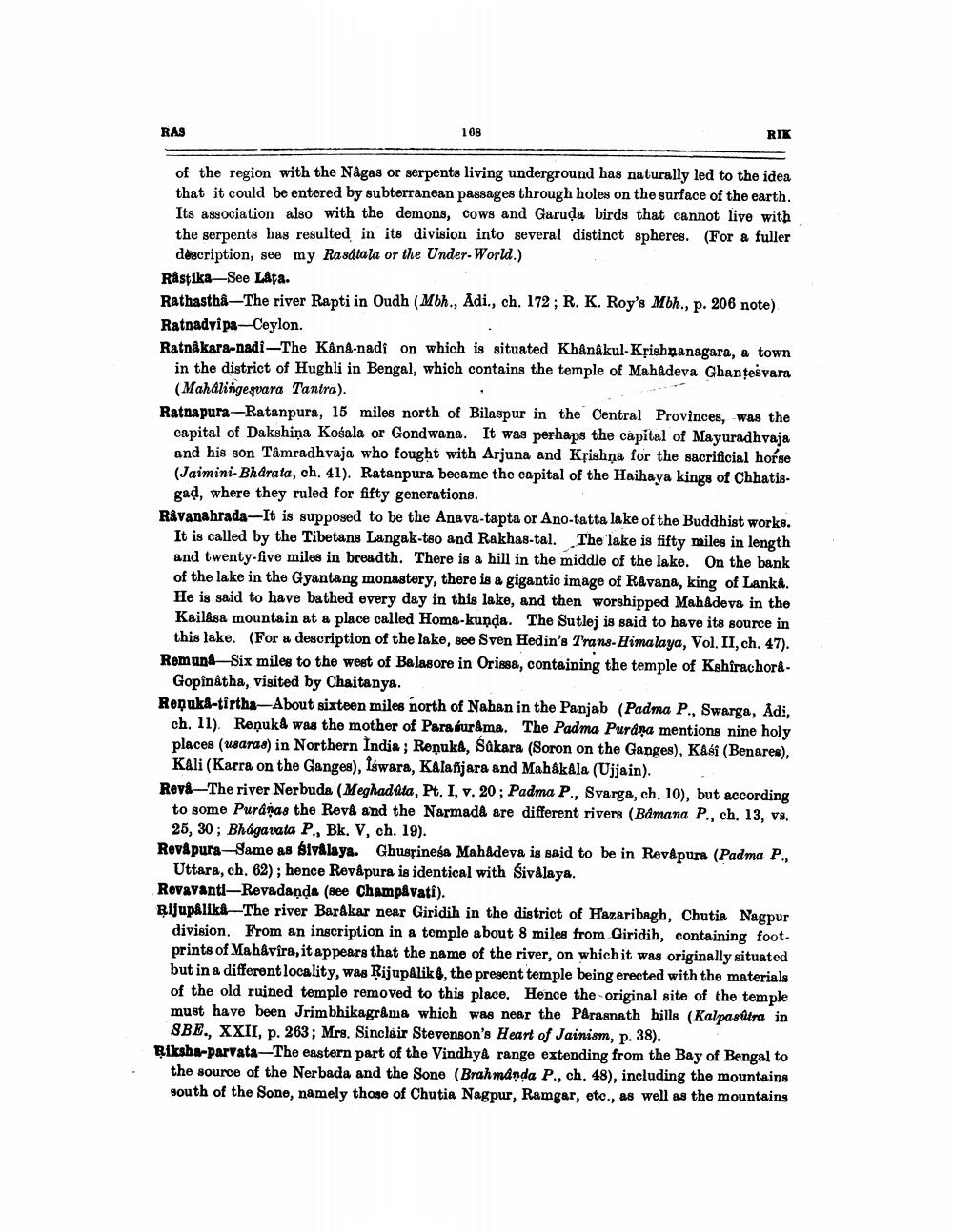________________
RAS
168
RIK
of the region with the Nagas or serpents living underground has naturally led to the idea that it could be entered by subterranean passages through holes on the surface of the earth. Its association also with the demons, cows and Garuda birds that cannot live with the serpents has resulted in its division into several distinct spheres. (For a fuller
description, see my Rasátala or the Under-World.) Rästika-See Laţa. Rathasthå-The river Rapti in Oudh (Mbh., Adi., ch. 172; R. K. Roy's Mbh., p. 206 note) Ratnadvipa-Ceylon. Ratnakara-nadi-The Kana-nadi on which is situated Khânâkul. Krishnanagara, a town
in the district of Hughli in Bengal, which contains the temple of Mahadeva Ghantesvara
(Mahdlingesvara Tantra). Ratnapura-Ratanpura, 15 miles north of Bilaspur in the Central Provinces, was the
capital of Dakshina Košala or Gondwana. It was perhaps the capital of Mayuradhvaja and his son Tâmradhvaja who fought with Arjuna and Krishna for the sacrificial horse (JaiminiBharata, ch, 41). Ratanpura became the capital of the Haihaya kings of Chhatis
gad, where they ruled for fifty generations. Råvanahrada-It is supposed to be the Anava-tapta or Ano-tatta lake of the Buddhist works.
It is called by the Tibetans Langak-tso and Rakhas-tal. The lake is fifty miles in length and twenty-five miles in breadth. There is a hill in the middle of the lake. On the bank of the lake in the Gyantang monastery, there is a gigantic image of Ravana, king of Lanka. He is said to have bathed every day in this lake, and then worshipped Mahadeva in the Kailasa mountain at a place called Homa-kunda. The Sutlej is said to have its source in this lake. (For a description of the lake, see Sven Hedin's Trans- Himalaya, Vol. II, ch. 47). Remani-Six miles to the west of Balasore in Orissa, containing the temple of Kshirachora
Gopinatha, visited by Chaitanya. Renuka-tirtha-About sixteen miles north of Nahan in the Panjab (Padma P., Swarga, Adi,
ch. 11). Renuka was the mother of Parasurama. The Padma Purana mentions nine holy places (usaras) in Northern India; Renuka, Sakara (Soron on the Ganges), Kasi (Benares), Kali (Karra on the Ganges), Iswara, Kalaħjara and Mahakala (Ujjain). Reva—The river Nerbuda (Meghadata, Pt. I, v. 20; Padma P., Svarga, ch. 10), but according
to some Puranas the Reve and the Narmada are different rivers (Bdmana P., ch. 13, vs.
25, 30; Bhagavata P., Bk. V, ch. 19). Reväpura-Same as bivalaya. Ghussinesa Mahadeva is said to be in Revapura (Padma P.,
Uttara, ch. 62); hence Revåpura is identical with SivAlay&. Revavanti-Revadanda (see Champivati). Rljupalika The river BarAkar near Giridih in the district of Hazaribagh, Chutia Nagpur
division. From an inscription in a tomple about 8 miles from Giridih, containing foot. prints of Mahavira, it appears that the name of the river, on which it was originally situated but in a different locality, was RijupAlik 4, the present temple being erected with the materials of the old ruined temple removed to this place. Hence the original site of the temple must have been Jrim bhikagrams which was near the Parasnath hills (Kalpastra in
SBE., XXII, p. 263; Mrs. Sinclair Stevenson's Heart of Jainism, p. 38). Riksha-parvata-The eastern part of the Vindhyê range extending from the Bay of Bengal to
the source of the Nerbada and the Sone (Brahmanda P., ch. 48), including the mountains south of the Sone, namely those of Chutia Nagpur, Ramgar, etc., as well as the mountains




